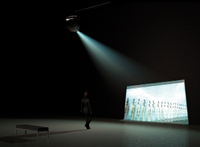May 30, 2007
FEEDBACK

Responsive Art
FEEDBACK focuses on art responsive to instructions, input, or its environment and creates one possible narrative of the multi-faceted histories of art that uses digital technologies as a medium. FEEDBACK interweaves two themes relating to responsive art. One theme traces the concept of feedback from art based on instructions—be they natural language or code—to art that sets up open systems reacting to input from its immediate environment or the Internet. A second theme explores the concept of light and the moving object and image from Kinetic Art and Op Art to responsive notions of television and cinema. FEEDBACK links these themes in order to illuminate how different artistic practices developed over the past 50 years are interconnected and have informed each other. The exhibition is not a historical survey but features a selection of pieces that underscore how related ideas have been expressed at different points in time. Artworks are not presented in chronological order but in thematic groups or pairs that branch and connect.
Manfred Mohr, Vera Molnar, Charles Csuri, Sol LeWitt, Casey Reas, Roman Verostko, 5voltcore, Harold Cohen, Christa Sommerer & Laurent Mignonneau, Hans Haacke, Edward Inhatowicz, David Rokeby, Lygia Clark, Hachiya Kazuhiko, Robert Rauschenberg, Eddo Stern, Mary Flanagan, Paul Sermon, Victoria Vesna, Boj & Diaz, Antoni Muntadas, Marcel Duchamp, László Moholy-Nagy, Alejandro & Moira Sina, Herwing Weiser, Takis, James Seawright, Jean Tinguely, Chico MacMurtrie/Amorphic Robot Works, Nam June Paik, Cory Arcangel, JODI, Wolfgang Staehle, Thomson & Craighead, Jennifer & Kevin McCoy, Marie Sester, Jenny Marketou, Char Davies.
TELEMATICS AND GLOBAL CONNECTIONS
Artists have used devices ranging from faxes and phones to satellite TVs in works that involve remote locations. In a 1978 report to the French president Giscard d’Estaing, Simon Nora and Alain Minc coined the term telematics for the combination of computers and telecommunications. Using ‘new technology’ such as video and satellites, artists in the 1970s began to experiment with ‘live performances’ and networks that anticipated the interactions currently taking place on the Internet. Digital technologies and the Internet have allowed for unprecedented possibilities of ‘being present’ in various locations at the same time.
CYBERNETICS, OPEN SYSTEMS AND INSTRUCTION-BASED ART CYBERNETICS AND OPEN SYSTEMS
In the 1940s, Norbert Wiener coined the term ‘cybernetics’—from the Greek term ‘kybernetes’ meaning ‘governor’ or ‘steersman’—to specify the important role that feedback plays in a communication system. In Cybernetics: or, Control and Communication in the Animal and the Machine (1948), Wiener defined three central concepts crucial to any organism or system: communication, control, and feedback. During the 1960s artists increasingly started to think about technological systems, the systems of the social world and aesthetic systems. In connection with movements such as Fluxus and Conceptualism, artists explored generative and ‘open systems’ for the creation of culturally and politically responsive art.
INSTRUCTION-BASED ART ::
A set of instructions is the basis for many art works. Art created by the Dada movement in the early 20th century was often based upon formal instructions. In the 1960s, the Fluxus movement and conceptual art, such as Sol LeWitt’s wall drawings, emphasised variations of formal instructions and focused on concept, event, and audience participation as opposed to art as a unified object. Since the 1960s instruction-based artistic practice has been making use of computational procedures connected to output displays, from early plotter printers to digital screens and projections.
KINETICS / OPTICS
In scientific terms, kinetic energy is the energy possessed by a body by virtue of its motion, and kinetic art, which peaked from the middle 1960s to the middle 1970s, produces movement, often through machines activated by the viewer. Kinetic Art overlaps with the optical art or Op Art of the 1960s, in which artists such as Victor Vasarely, Julio Le Parc, and Nicolas Schöffer used patterns to create optical illusions of movement, vibration and warping. The term first appeared in print in Time magazine in October 1964, but works falling into the Op Art category were produced much earlier. The influence of the Kinetic and Op Art experiments with ‘machines’ that produced light and movement can be traced in many digital installations today.
CINEMATICS
Aspects of Kinetics and Op Art find their continuation in responsive forms of television and digital cinema that have been developed since the late 1960s. Artists have constructed moving images based on responses generated from the apparatus itself—such as TV sets or projectors driven by motion and vision tracking; through to the software-driven selection and manipulation of data; or navigation systems that allow the viewers’ bodies to drive and respond to the imagery.
ESSAYS:
CHRISTIANE PAUL FEEDBACK: FROM OBJECT TO PROCESS AND SYSTEM
Download PDF
JEMIMA RELLIE FEEDBACK/FEEDFORWARD
Download PDF
CHARLIE GERE ART AS FEEDBACK
Download PDF
Posted by jo at May 30, 2007 12:59 PM
